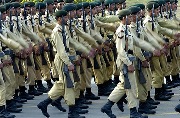The would-be Times Square bomber and US citizen Faisal Shahzad is said to have told his US interrogators that he went to North Waziristan and was trained by the Tehrik-e-Taliban Pakistan. The US media, barring some exceptions, has since gone berserk. North Waziristan is where the Pakistani army must go now, the assumption being it is not deployed to the area or has left it unattended. Consider some facts.
First, for now, there is no solid evidence that Shahzad went to North Waziristan. Two, the Tehrik says it does not know him, but they support his actions. But no, Pakistan’s stretched-thin military must focus on the restive agency, and is accused of always finding reasons not to because the deadliest militant groups holed up there only target Afghans, Indians, and Westerners.
Nothing could be further from the truth.
There are more troops deployed to and around North Waziristan than South Waziristan, where the army launched Operation Rah-e-Nijat (Path to Salvation) last October. Statistics compiled from media reports and local journalists, and corroborated with data from the military, show that since 2005, militants based in the area have launched between 70 and 80 raids on different army posts in North Waziristan. These attacks have resulted in about 200 casualties, including over 50 soldiers killed.
There have been more than 200 reported IED attacks on army convoys resulting in nearly 400 casualties, with about one-third killed. Militants have ambushed army convoys at least 25 times, resulting in over 100 casualties. Nearly 600 mortar and rocket attacks on army camps have been recorded, causing nearly 150 casualties, half of them killed. Four reported suicide attacks on army check-posts have killed 12 soldiers and injured 47.
Statistically, the groups in North Waziristan, in five years, have killed and injured more Pakistani troops in and around the area than they have Afghans, Indians and Westerners inside Afghanistan since October 2001 — considering that the Taliban in Afghanistan are not just operating out of North Waziristan. Pakistan’s armed forces are being attacked, and killed, because the military has mounted constant, targeted operations against groups based in North Waziristan — even as it has gone for more sweeping operations in Bajaur, Buner, Khyber, Lower Dir, Malakand, and South Waziristan. Pakistani troops are not being killed because the military, or the Inter-Services Intelligence, is harbouring militants as part of some anti-Afghanistan, anti-US-NATO-ISAF or anti-India strategy.
In 2005 alone, the military launched 17 operations in North Waziristan including snap action, area domination, and cordon-and-search operations. In 2006, it conducted 16 such operations. There was a lull for a few months after a peace agreement in late 2006, which lasted until about mid-2007. Following the breach of this agreement by the militants, there was an unprecedented increase in insurgent activity, forcing the military to deploy more troops to the area.
From that point onwards, because the military has had to operate in Bajaur, Buner, Khyber, Lower Dir, Malakand, and South Waziristan, it has focused on using force selectively in North Waziristan to deny the militants area domination. There was, and has been, trouble in North Waziristan but there was more trouble emanating from South Waziristan, Bajaur and Malakand and they demanded operational priority — because that is where the TTP and its affiliates were based and operating not just against the army and Frontier Corps, but launching terrorist attacks across Pakistan.
From 2008 until this year, operations in North Waziristan have also included the use of aerial platforms in support of ground operations. The casualty figures show that since 2005 in North Waziristan, the military has lost over 300 men, while the number for the injured is nearly 1,000. Over 600 militants have also been killed, half of them from US Predator strikes for which much human intelligence comes from Pakistani sources.
Operational strategy is not about doing what is desirable, but what is achievable — step by step. Pakistan is doing all it can to put down militants. At places the military has succeeded in the first phase and now has to focus on the second, more important phase of consolidation and rebuilding. The sheer size and treacherous terrain of the troubled area make operations extremely difficult. And consolidation demands money, which is not forthcoming.
Unlike the media Napoleons in the US, the US generals understand the complexity of operating in North Waziristan. Which is why, during their recent visit to Pakistan, CIA Director Leon Panetta and National Security Advisor, former general James Jones, said that while an operation in North Waziristan is important, its timing can only be determined by Pakistan.
The army appreciates the situation; the commentators, with their own angles, situate the appreciation. The fact is that despite several constraining factors Pakistan has managed far more than what the world coalition in Afghanistan has thus far.
The writer is national affairs editor, ‘Newsweek Pakistan’





